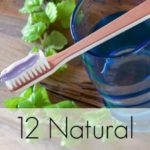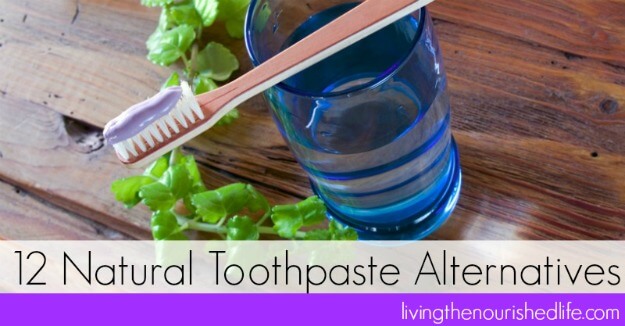If you’re worried about the ingredients in commercial toothpastes, don’t worry, I’ve gathered together a list of 12 natural toothpaste alternatives. Some are a bit weird and might shock you, but this list was made BY my readers FOR my readers.
Natural toothpaste alternatives are all the rage these days.
So, what’s wrong with commercial toothpaste?
Well, like most commercial health and beauty products on the market, toothpaste has been industrialized over the years.
Here are just a few of the questionable ingredients commonly found in commercial toothpaste:
Fluoride.
While fluoride is supposedly the ingredient that prevents cavities, it doesn’t do that job very well and can actually be very toxic to the body. In fact, if you suffer from acne outbreaks around the mouth and chin area, fluoride toothpaste may be the cause! (If you haven’t already, check out The Case Against Fluoride and The Fluoride Deception for more information.)
Fluoride-free toothpaste is becoming more common, but unfortunately, it’s not the only ingredient in toothpaste you should be avoiding. Read more about fluoride dangers here.
Titanium dioxide.
There are some concerns that titanium dioxide is carcinogenic. The biggest problem is that nano-sized particles of titanium dioxide can be absorbed through the mouth and may cause toxic damage in the cells of the body.
Glycerin.
This is found in almost every toothpaste on the market (even the natural ones). Glycerin helps give toothpaste its pasty texture and keeps it from drying out. But it can also leave a coating on your teeth that prevents them from remineralizing.
Sodium lauryl sulfate.
It gives you the foamy cleaning action we all expect from toothpaste, but sodium lauryl sulfate is also a strong chemical surfactant that doesn’t belong in our bodies.
Artificial sweeteners.
I don’t know about you, but I generally avoid chemical sweeteners like sorbitol and saccharin. Unfortunately, these are commonly used in commercial toothpaste to make them taste sweet.
So, what are some natural toothpaste alternatives?
I asked you on The Nourished Life Facebook Fan Page what you use instead of commercial toothpaste.
And as I expected, you all gave some great responses–so many that I really couldn’t list them all! But here are twelve ideas to get you started:
12 Natural Toothpaste Alternatives
1. Sea Salt
How much more natural can you get than brushing your teeth with salt from the sea?
It’s easy, too: just dab your toothbrush in sea salt and brush away as usual.
Concerned about abrasion?
Me, too. You can also dissolve the salt in water first and then dip your brush in the saltwater before brushing.
2. Baking Soda
This has got to be one of the most popular natural toothpaste alternatives.
Like sea salt, you can just dip your toothbrush in baking soda and brush like normal. Or you can dissolve it in water first and use the brine for brushing (just like the sea salt).
A lot of people use baking soda as a base for homemade tooth powder. You mix it with a few drops of peppermint essential oil and stevia to give your mouth a minty fresh feel.
3. Hydrogen Peroxide
Hydrogen peroxide is known for keeping teeth clean and white, and many people use it instead of toothpaste.
Jessica on Facebook suggests, “Dip your toothbrush in hydrogen peroxide and then in a 50/50 mixture of baking soda and fine sea salt.”
The only potential problem with hydrogen peroxide is if you have amalgam fillings: peroxide may leach mercury from your fillings.
4. Herbal Tooth Powders
Herbal tooth powders can be used in place of toothpaste.
They do a good job of cleaning, and the herbal ingredients can also help ease inflammation, pain and infection throughout the mouth.
5. Dry Brushing
It doesn’t get much more simple than this.
Tired of looking for a natural toothpaste alternative?
According to some, there’s no need to use anything at all: dry brushing does the job. But while it does seem to work well enough, there’s no minty mouth feel (like we’re all used to, of course) and might feel a little strange.
6. Brush with Pure Water
If dry brushing doesn’t quite cut it for you, try brushing with pure water.
This also works surprisingly well for clearing debris from the teeth, but you still don’t get that minty mouth feel.
7. All Natural Soap
Yes, you can brush your teeth with soap.
I’ve tried this one a few times, and while it does work, it also tastes pretty, well, soapy.
Not exactly the natural toothpaste experience I was looking for personally.
But if you decide to try it, trying a natural soap like peppermint castile soap.
8. Tooth Soap
For those who aren’t keen on using actual soap in their mouths, there are quite a lot of brands of specially designed tooth soaps on the market as a natural toothpaste alternative. Just try to find one without additives.
9. Coconut Oil
Coconut oil is another great natural toothpaste alternative.
Why?
Its antifungal and antibacterial properties come in handy for mouth cleaning.
Coconut oil can be used alone and combined with other ingredients listed here (like baking soda and essential oils).
10. Waterpik
Getting a Waterpik has been on my to-do list ever since I read Cure Tooth Decay by Rami Nagel.
Now that I have one, I’m so glad I took the plunge! This little device can work some wonders cleaning teeth and gums. Some say the results are nothing short of miraculous. If you have braces or trouble with irritated gums, you definitely need to start water flossing.
Rami Nagel suggests in his book that you use salt water for oral irrigation, which can enhance the benefits.
11. Essential Oils
These can be bought at a local health food store or from a reputable online store. Learn where I shop for high quality therapeutic essential oils online.
Sometimes I just use a drop or two of peppermint oil on my dampened toothbrush if I want a quick and easy way to get my mouth feeling clean and minty fresh.
12. Oil Pulling
Never heard of it?
Here’s a post that explains what oil pulling is and how to do it.
Basically you swish about one tablespoon of oil (I use coconut oil) for several minutes. Then brush with plain water or use one of the methods listed above. Trust me, your teeth have never felt this clean!
Do you have a favorite natural toothpaste alternative? Please share in the comment section below!
More Articles and Recipes for Oral Health:
- Natural Whitening Toothpaste Recipe with Activated Charcoal
- 7 Natural Toothpaste Recipes
- Black Oil for Natural Teeth Whitening
- Homemade Mouthwash Recipe for Whitening and Remineralizing
- Honey Mask For Acne
- Best Essential Oil for Face
- Why Do I Crave Peanut Butter?
- Homemade Lotion Recipe
- Lighten Hair Naturally
- Where to Buy Beeswax for Lip Balm
- Difference Between Refined & Unrefined Coconut Oil
- Benefits of Raw Eggs
More Natural Toothpaste recipes:
- DIY Toothpaste
- Why I Threw Away My Toothpaste
- Homemade Toothpaste Recipe
- Homemade Squeezable Toothpaste


